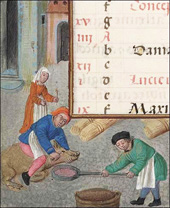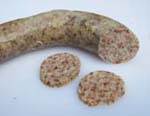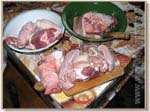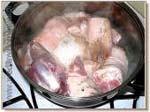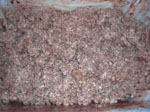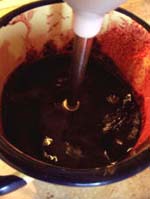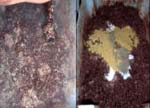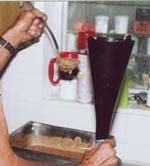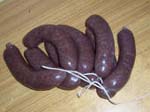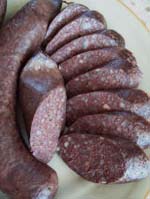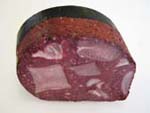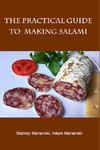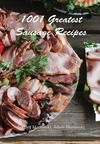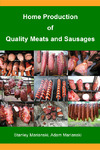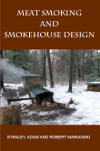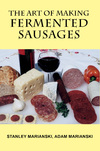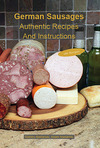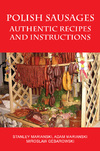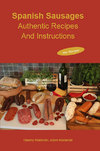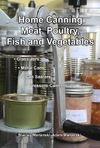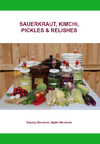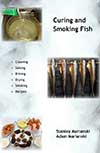Meats and Sausages
Blood Sausages
Blood sausages have been made for thousands of years, and every country has its recipes. Different cultures and/or regions have their versions of blood sausage. These recipes are generally variable takes on a similar theme. Whatever the name – Black pudding (UK, Ireland), Boudin noir (France), Blutwurst (Germany), Morcilla (Spain), Jelito (Czech), Kaszanka (Poland), or Mustamakkara (Finland), the main ingredients are as follows:
- Blood – either from pig, sheep, lamb, cow, or goose (each author believing their choice is preferred)
- Filler that varies with region (e.g., oatmeal, buckwheat, breadcrumbs, barley, or other grains);
- Onions and regional spices.
These are typically smashed and stuffed into a sausage casing.

Looking at the above formulas, it is obvious that the non-sliceable formula (with a filler) costs less to produce, and this kind of blood sausage can be found all over the world. The addition of filler material makes it very economical and the number of recipes that can be created is only limited by the imagination of the sausage maker.
Meat selection
Blood sausages were originally made from inexpensive raw materials such as pork head meat, jowls, tongues, groins, skins, pork or veal lungs, pork liver, beef and lamb liver, pork snouts, beef and liver lips, udders, beef and lamb tripe, veal casings, pork stomachs, pork heart, boiled bone meat and of course blood. This way, any part of the animal was utilized, and a highly nutritional product was made. In times of war and other hard times when meat was scarce, fillers were added to increase the volume of the sausage. Generally speaking, blood sausage is composed of diced, cooked fat pork and finely ground cooked meat and gelatin-producing material mixed with beef or pork blood. The whole is spiced and stuffed into a casing. Sometimes, pork or lamb tongues are included, and the product is known as tongue and blood sausage.
- Fat
- Back fat is the best as it is hard and is less likely to smear. Fat from pork butt and jowl fat are also hard fats, but belly fat (bacon) is soft. You can use any little fat pieces and fat trimmings. Sliceable blood sausage (without fillers) looks much nicer with visible pieces of white fat in it. To achieve this effect, pork back fat should be cut into 4-5 mm (about 3/16”) cubes, which should be blanched briefly (5 min) in hot water (90º-95º C, 194º-203º F). This seals the surface of fat cubes and prevents blood from entering and discoloring it.
- Skins
- Skins are a very important ingredient as they contain a lot of collagen, which will turn into gelatin during heat treatment. During subsequent cooling, this gelatin will become a gel, and that will create a firmer texture for the sausage. In sliceable blood sausages that are usually consumed cold, this will positively contribute to the sliceability of the sausage. In non-sliceable sausages (with fillers and consumed hot) this will add firmness to the sausage. Don’t discard skin when trimming pork butts and freeze it for later use in head cheeses, blood or liver sausages.
- Fillers
-
Many countries have their own traditionally used fillers that are added to a sausage mass:
- England and Ireland - rusk, barley, rice, potatoes, flour, oatmeal.
- Poland - buckwheat groats, barley, bread crumbs, rice, semolina.
- Spain - milk, rice, eggs, cheese, almonds, pimentos, parsley, apples.
- Sweden - rye meal, raisins.
- Argentina - wheat gluten (seitan), corn flour, flour.
Filler material such as rice, barley, or buckwheat groats must be pre-cooked. Groats can be found in supermarkets, but they have been factory-processed and are ill-suited for making blood sausages. The real natural groats, also known as steel-cut oats, can be ordered from online distributors such as the Sausage Maker or Bulk Foods. Oatmeal is normally soaked overnight. The addition of filler material makes a sausage very economical. With such a variety of filler materials, different meats that can be selected, and spices that can be chosen, it is hardly surprising to see the huge number of recipes floating around. And as we often repeat, it is not the recipe that makes a great sausage, but the way you make it.
Blood
Blood from any animal, including poultry, can be used for making blood sausage, although pig and cow blood are most often used. Pig blood has a nicer, lighter color than blood from cattle, which is much darker, commonly brown, and sometimes almost black. This can be attributed to the age of the animal at the time of slaughter, the pigs are much younger. Due to its high water content (85%), blood is a highly perishable product attracting bacteria and must be immediately collected and cooled quickly to about 37°F (3°C) and stored for up to 2 days at about 32°F (0°C) or in a refrigerator. Then, it must be processed. To extend its life, blood can be frozen. Beef blood can be very dark red or almost black in color and was traditionally used in England. The amount of blood in a sausage can vary from 5%-60% and the more blood, the darker the sausage.
Sliceable blood sausages, which are often eaten cold, contain less than 10% blood and are much lighter in color than non-sliceable sausages (30% - 60% of blood), which are darker. If an excessive amount of blood is added to a sliceable sausage, solid chunks of meat have a tendency to sink and accumulate in one area of the sausage. Blood sausages with filler material don’t face this problem as the filler material acts like a sponge, and more blood can be added, making the sausage darker.
Blood coagulates (forms solids) easily and is stirred frequently when collected during the slaughter. Mixing blood and adding about 5% salt (re-adjust the recipe for salt content) will result in stabilized blood. It must used within 1-2 days and should be cold when it is mixed with other ingredients. Before use. it must be stirred again and filtered through a cheesecloth. Otherwise, the sausage may contain lumps of blood. If collecting blood during the slaughter, keep on mixing it well; otherwise, it will coagulate. Blood is a nutritious food for bacteria and should be cooled down quickly and placed in a refrigerator. It is advisable to process blood no later than on the second day. If the refrigerator is capable of maintaining temperatures of 1º C (33º F), the blood may be kept for 2-4 days. Adding salt or nitrite is not effective in extending blood’s shelf life, but blood can be frozen for later use. In time, blood plasma separates from the blood, and water accumulates on top, so the blood must be stirred before use.
Blood Salting (Curing)
Blood is a very perishable product and has to be refrigerated. In the past blood was preserved by adding 5 kg of salt to 100 kg of blood and mixed well together. Such preserved blood was stored up to 48 hours at 4-6°C (39-42°F). Today, an anticoagulation agent will be immediately added to freshly collected blood, which will be stored below 3°C (37°F) for up to 48 hours.
Commercial producers add anticoagulation chemicals like trisodium citrate to prevent the coagulation of blood. A good idea is to filter blood through a fine sieve or cheesecloth before use to eliminate larger lumped particles that may be visible in a sliced sausage.
Getting blood in a metropolitan area is not easy. The best advice is to talk to the local butcher or a sausage maker. They make blood sausages and order frozen blood from meat purveyors.
Salt, Spices and Other Ingredients
Blood sausages are perishable products and contain a large amount of water (blood). Adding salt has little effect on the preservation of the blood, and salt is applied mainly as a flavoring ingredient between 1.5 and 2.2%. Like in most other sausages 1.8% of salt will agree with most people. Blood sausages like highly aromatic spices such as pepper, thyme, marjoram, caraway, pimento, cloves, nutmeg, allspice and coriander. For a milder taste onions are frequently fried in fat until glassy and then added to the mixture. Often, apples, pine nuts, chestnuts, raisins, and cream are added. Fresh onions are commonly added to blood sausages, but they can impart a sour taste to the product. For a milder taste onions are fried in oil first until they become glassy looking and of light yellow color.
Manufacturing process
- Cooking. Blood sausage, head cheese, and liver sausage belong to a special group of sausages. What makes them different is that meats and fillers are pre-cooked before being minced, mixed, and stuffed. The fat is not cooked but only scalded and diced into cubes. The blood is not cooked.
- Grinding. Except fat, all other pre-cooked meats are cooled, ground through a 1/8” (3 mm) plate, and mixed together.
- Mixing. Diced fat, blood, salt, and spices are added and everything is mixed together.
- Stuffing. The blood sausage mass is much softer than the mixture for regular sausages. It is stuffed with a stuffer but can be ladled into the casing through any suitable funnel. Traditionally, blood sausages were stuffed into beef bungs or hog middles, but any natural or synthetic casings will do. Prick any visible air pockets with a needle otherwise, the sausages will swim up to the surface during cooking.
- Cooking. The sausages are cooked in water for about 40 minutes at 176-180° F (80-82° C). If they raise to the surface, remove air pockets with a needle.
- Cooling. Chill in cold water, wipe off the moisture, and store in a refrigerator.
If a smoked flavor is desired, add sodium nitrite (Cure #1) during mixing. Mix, stuff, and cook the sausage, then follow with smoking. A simpler solution is to add liquid smoke during mixing. Cool and refrigerate. Blood in a finished sausage was already cooked, so the sausage can be eaten cold. Fried blood changes its color to dark brown-black. In some countries, for example in England, black colorants like Black PN or Brilliant Black (E151) were added but these are no longer permitted in the EU.
Composition of some known blood sausages:
- Black pudding - UK, pigs blood, pork fat, and cereal (oatmeal and/or barley).
- Boudin Noir - France, pig blood, pork fat, breadcrumbs.
- Blutworst - Germany, pig blood, diced bacon and lungs, barley.
- Drisheen - Ireland, sheep blood, oatmeal or breadcrumbs.
- Kaszanka - Poland, pig blood, lungs, liver, buckwheat grouts.
- Morcilla - Spain, pig blood, pork fat, long grain rice.
- Navajo Indian - USA, sheep blood, cornmeal.
White Blood Sausage
A white blood sausage is made from pork without blood. Many countries have their own versions:
- England - White Pudding - diced pork, oats or bread, suet, sugar, onions, cinnamon.
- France - Boudin Blanc - pork, milk, parsley, rice, pepper, onions. Boudin blanc de Rethel carries PGI certificate and must be made without filler material. Pork meat, fresh whole eggs and milk.
- USA - Boudin Blanc, Cajun Style - pork meat, pork liver, rice, onions, parsley, garlic, pepper.
- Poland - White Blood Sausage-pork meat, pork liver, rice, onions, marjoram.
Instructions for Making Blood Sausage with Buckwheat Groats or Barley
Often, many people buy an entire pig and share the costs of production. By doing this they have access to meats that a person living in a city is not not able to obtain. In a large American city, a person usually buys meats from a local supermarket, and the following meats are always available: pork butt, pork picnic, pork liver, pork hocks, and tongues; back fat is harder to obtain, but softer pork belly will do. In a non-sliceable blood sausage, meat selection is of lesser importance; after all, a large part of the sausage is a filler.
- Meats should be washed in cold running water.
- Cook meats in hot water at 85º-90º C (185º-194º F) until soft. Don't cook liver which acts as an emulsifier-read more about liver in Liver Sausages.
- Pork skin requires a longer cooking time, so a separate pot should be used. Skins should be cooked at 85º-90º C (185º -194º F), and when properly cooked, they should hold their shape, but you should be able to put your finger through them.
- Place precooked meats on a flat service to cool them. In sliceable blood sausages, it is a good idea to wash all meats with hot water (80º -90º C, 176º -194º F) to remove any small pieces of fat or meat that might adhere to chunks of meat. This will largely improve the looks of a sliced sausage.
- Save meat stock for further use.
Note It is much easier to remove skin from tongues before cooking. Also, if tongues are to be cured, the skin should be removed first as it will act as a barrier preventing salt and nitrite diffusion.
,To remove pork tongue skin, place the tongue for 3-5 minutes in 70º C (158º F) water. The greyish skin on the tongue is easily removed. To remove beef tongue skin, place the tongue for 5 minutes in 80-90º C (176-194º F) water. The outer layer on the surface of the tongue will be easy to remove.
- Contrary to the established methods for typical sausage manufacturing, meats used in blood sausages are normally cut with a knife into visible cubes. This can be easily noticed in sliceable blood sausages where emulsified skins, meats, broth (meat stock), and fats are held together.
- When making non-sliceable blood sausages, grind meats with a smaller plate (5-6 mm, 1/4") or according to the recipe. The size of the plate is basically up to you, some people like to feel and taste individual pieces of meat in a sausage, so a larger plate (8 mm, 3/8") is used.
- Previously cooked skins should be minced with 2-3 mm (1/8") plate. It is a good idea to further emulsify skins in a food processor, adding about 20-30% of hot broth (in relation to the weight of skins).
- Ground meats are evenly spread on the bottom of the mixing tub.
Although barley (kasza jęczmienna in Polish) or buckwheat groats (kasza gryczana in Polish) may be cooked in water, it is common knowledge the final product will be of much higher quality if the material is cooked in broth (from cooking meats) instead. Many people mix barley and buckwheat together (half and half). For each 1 kg of filler material, 1.5 - 2 kg (2 liters) of broth is needed. Using more than double the amount of broth in relation to the weight of barley will make your filler material overcooked, soft, and smeary, which will negatively affect the texture, sliceability, and looks of the sausage.
- Skim off the excess fat from the meat stock surface and bring the broth to a boil.
- Start slowly adding groats, continuously stirring the mixture. After adding groats, you may have to readjust the temperature to bring the mixture to a slow boil. The groats should absorb the meat broth. The total time will be about 30-40 min, and the filler material should be soft and loose, exactly like a properly boiled rice.
- Switch off the heat source and cover the pot. Let it sit for 1 hour. This allows for total absorption of broth by the groats. Undercooking filler material carries the danger of sausages bursting open when cooked in water, especially when casings are stuffed firmly. Until the process is perfected, it is advisable to make sure that groats are cooked until, soft even if that requires cooking them for 1 hour. It should be noted that buckwheat groats cook faster than barley, and two should be cooked in separate vessels.
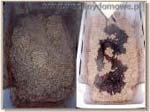
Hot groats, straight from the pot are spread evenly on top of the meat, without mixing. Then, blood is poured over the groats (right part of the photo above). The meats or groats should be warm but not hotter than 60º C (140º F) otherwise blood protein will start cooking and blood will not mix well with other ingredients.
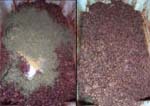
Everything is mixed well together and ready for stuffing. Before stuffing all of the meat mass a test should be made: a small trial sausage should be made and cooked and then tested. Bear in mind that in a hot product, the flavor of salt and spices seems more intense than in the same product that is eaten cold.
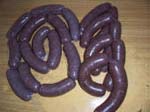
If sample sausages are acceptable and no more salt, pepper, or other spices are needed, we can proceed with stuffing sausage mass into casings. The sausage mass should be warm as this helps immensely when stuffing. The hog casings should be filled firmly but not tight and form into 12 - 15 cm (6 inch) links. During hot water cooking casings will lose some of its elasticity and filler material such as groats, rice or bread crumbs may swell and expand. Finished (cooked) can be frozen for later use. It is also possible to freeze stuffed sausages (uncooked) in a freezer and then, at a later date, de-thawing and cooking them in hot water.
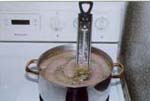
The picture above depicts liver sausages being cooked in hot water. The sausages are immersed into boiling water and the temperature will immediately drop lower. The cooking process will last about 30 minutes at 80º C (176º F). A rule of thumb says that at 80º-85º C (176º-185º F) about 15 minutes is needed for each 1 centimeter of the diameter of the sausage. Internal sausage temperature should reach 68º-70º C (154º-158º F).

